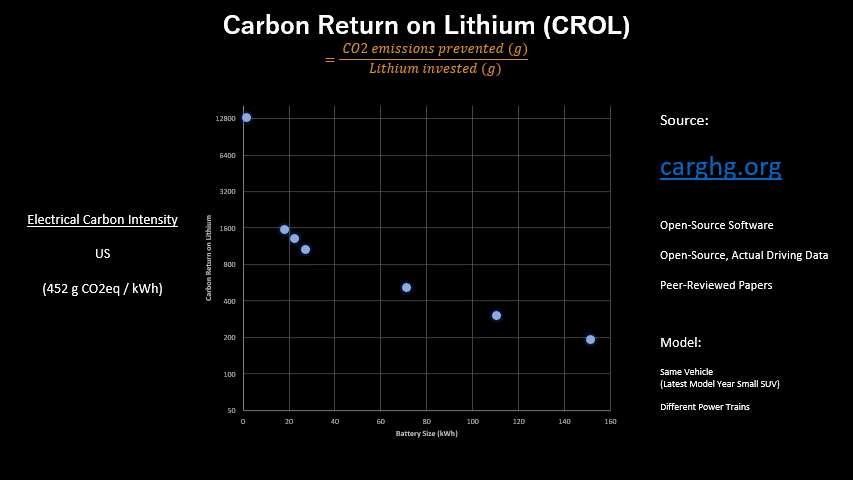
Ahead of May's G7 Summit in Hiroshima, Toyota's Chief Scientist Dr. Gill Pratt spoke about the importance of diverse options as part of the unique decarbonization approach Japan seeks to share with the world.
The right mix of BEVs, PHEVs, HEVs
Dr. Pratt

Next, let’s look at the issue from an economic perspective.
This graph shows the carbon return on lithium; that is, the amount of CO2 emissions prevented divided by the lithium invested, in grams. What does this graph tell us? That initially, small-sized batteries are the most effective way to electrify cars.
The effect weakens as battery size increases because the average travel distance per vehicle is not long. Carrying around excess battery capacity that could be used more effectively elsewhere is wasteful, akin to holding surplus inventory.
The points on the graph are grouped into BEVs, PHEVs, and HEVs, with HEVs having the highest carbon return on lithium.
This graph is based on average carbon emissions for electricity in the United States.
If we used data from Switzerland, where carbon emissions per kWh are about one-tenth of those in America, the result for BEVs would improve. However, PHEVs would also fare better, albeit not to the extent of BEVs.
In other words, while BEVs are more effective if there is easy access to clean power charging infrastructure, other electrified vehicles can cut more carbon emissions per gram of lithium.
In the case of Wyoming, which relies almost entirely on fossil fuels for electricity, the large batteries of BEVs give them a worse carbon return on lithium than gasoline-powered vehicles, to the extent that they don’t even fit on the graph.
I’m not contending that we should make only BEVs. Although the world has sufficient resources to build many BEVs, we don’t have enough to make every car a BEV.
Just as we gave more water to the rowers in our lifeboat, we should channel BEVs to the places where they will have the greatest effect; namely, to customers with ready access to clean charging.
To achieve the best overall result, other customers should replace their conventional gasoline-powered vehicles with PHEVs or HEVs instead of BEVs.
I’ll give a third example to help illustrate the point more intuitively. This is the layout for a facility in Japan.

Plants one and two make HEV batteries while the third plant is for BEV batteries. Each of the two HEV plants produces batteries for 210,000 vehicles per year.
Meanwhile the BEV battery plant, despite being many times larger than the HEV plants and consuming ten times more electricity, produces batteries for only 80,000 vehicles per year.
Although these BEVs are valuable to customers in certain areas, for those living elsewhere they are a wasteful use of resources.

